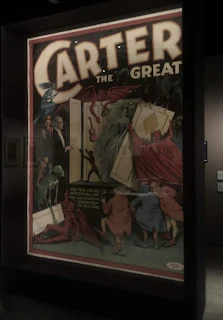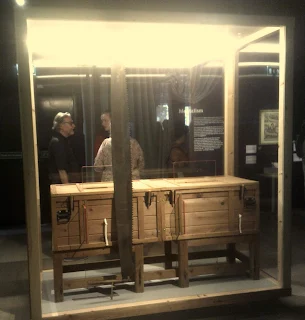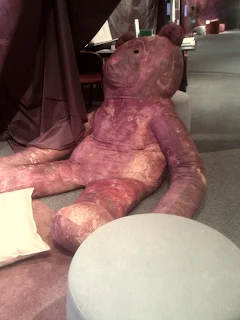ELAINE
ROCKETT
MANIFESTO
I write, therefore I am,
therefore I write...∞
I
have described my creative writing as 'opening up my soul and
splattering it onto the page'. I truly believe that we connect
through our feelings and I want my reader to feel that I have touched
a chord within their hearts. My ideal reader may well have suffered.
But, even if they haven't, and have led a life that's all sunshine,
lollipops and rainbows, I want them to sit up and take note with an,
'Oh, I suppose that
can
happen as well...' My writing is designed to
make people sit up and think and yes, also to stir things up a bit.
*
Blood is not always
thicker than water. Life is long (hopefully) and life is hard. Just
because someone is related to you doesn't necessarily mean that
you'll instantly, and always, adore them. In fact, the opposite may
well be true. Not all of us have familial relationships that are
sweetness and light and tickety-boo.
*
Parents, remember: a
child is for life, not just for Christmas. Parenting is not a job
that ends once your offspring become of an age where they can earn
their keep and you can chuck them out. Parental responsibility is
not just about putting food onto the table and a roof over their
heads- it's also about making an emotional connection. That
responsibility begins the moment that sperm hits that egg, and you
never know what you are going to get. You're supposed to love them
unconditionally, and if you don't feel that you can do that, then
stop that sperm from hitting that egg. Nurture them, and do your job
properly and they'll be ready to leave the family home somewhere
between the ages of 18-21; a capable, well-balanced adult. Neglect
that, and you deserve the rejection that will end up becoming your
life.
*
I use my characters to
show the world how some people suffer, especially when faced with
undiagnosed mental illness (maybe their own, or maybe that of someone
close to them). I always remember to include some happy,
well-balanced individuals alongside the damaged, lost souls to create
some balance.
*
I see 16-17 year olds as
very vulnerable beings, in that at that age you're expected to behave
like an adult, yet are often treated like a child. It's a massive
contradiction. You can have sex and get
married, but cannot buy alcohol or cigarettes. You can work and pay
tax but you're not entitled to a proper level of minimum wage or
benefits if you lose your job. You can leave home (or legally be
thrown out) but, again, cannot claim any supporting benefits if
you're (and this is most likely) on a very low wage. And you have to
suck all of this up without the right to vote for the political party
whom you feel are best placed to look after you. The exit years at
school are just as important as the early years. I put the needs of this
often neglected section of society to the fore in my novels, as
people need to sit up and take notice.
*
I have been known to
use events that have happened to myself, or that I've seen happen to
others as a springboard for ideas. I've also based some of my
characters on people I've met in real life. This has tended to
happen a lot more with the nastier individuals I've had the
misfortune to encounter, and their influence has resulted in them
being vilified on the page, with every fault blown up tenfold for
effect. I've often said, 'Upset me and you'll end up in a novel.' You have been warned.
*
I find it therapeutic
slinging my feelings down onto paper (better out than in). I have a
compulsion to write and document that's essential to my life.
Writing, in some ways is a form of revenge. You can get your own
back on those who've mistreated you and laugh with joy as you
document their foibles and the misfortunes you're able to create for
them. I do take a macabre sense of vindictive satisfaction in
imagining them reading about themselves (that's if these stupid
people even bother to read books and really, don't you agree that too
many people spend too much time looking at flickering screens
nowadays?) I let people know what's happened and, in doing so, I
exonerate myself from taking all of the blame in a situation. Writing is where you can
murder someone and not go to prison for it. Writing is using the
page as a psychiatrist. Writing soothes my soul.
*
I'm
a lover of art, history, heritage locations, a bit of
the supernatural and magic, so I like to include elements of these in
my writing. It makes sense to write about what you know. But you
also need to stretch yourself and research and write about what you
don't know. In that aspect, being a writer is great as you
get to be a reader too! I'm a big fan of a happy
ending, but I do want to diversify with this, and make the characters
do what they would do rather than what I want them to do. I once described story
writing as, 'A set of events that you can bend to your will.' But I
want to move on from this and allow my characters to control me (even
if only temporarily!)
*
As part of our MA induction,
we were asked to try the VIA Character Strengths Survey. It will
probably come as no surprise that my biggest strength was creativity.
But my second strongest point was humour. I always try and inject a
sense of fun into my work; maybe with a pithily delivered observation
or a hilarious line in dialogue. Not only is laughter a
good tension reliever both physically and mentally (as we all should
know) but a sense of it helps lighten a story that could otherwise
come across as too dark. It also offers contrast to the more serious
sections of my writing.
*
I
don't mean to offend, but people must meet me halfway with this- I'm
quite a direct person who's had a hell of a lot of experience in
working as a creative practitioner (as a fashion designer). No
is
a word I've heard a lot more than
yes.
Of course it's toughened me up. Those who may have had gentler
careers (or lives) have got to understand that there's no reason why
I should continually pander to touchy-feely people. However, as
I've matured I do try and take a kinder and more diplomatic approach.
I don't want to be the fool who rushes in, and do want to take a
more considered effect when offering criticism or contradiction. I
don't want to let myself down by being too blunt or forceful.
*
Of course I like positive
feedback. I'd be a strange being if I didn't. But I also have
plenty of time for constructive negative feedback. I love the sense
of achievement of having completed a job well. Yes, I am in
possession of an ego. But my egotism comes from achievement, not
from simply being. I want people to like my
work and think of me as a skilled craftsperson, and for that I have to
apply the many helpful things I've already learnt during this course.
*
Writing is my means of
communicating with the world. I can't turn it off, and neither would
I want to, hence I write, therefore I am, therefore I write...to
infinity, at the top of the page. I have no choice. I cannot not
write. Is it all about me? Yes.
Probably. But I want to use writing to both connect and to
entertain, and not just shove my opinions and thoughts down people's
throats.
*
Being true to myself is
also important. In my writing, I like to be honest to the point of
being brutal. I have developed my own style, which I'm aware will
change over time, like a signature. I endeavour to explore that
style, go with the flow and make it my own. I refuse to be afraid of
it. A writer doesn't have
to be many- or every- type of writer. I would never be interested in
writing fantasy or sci-fi, for example. But, in everything that I
put down onto the page, my style will peep out. I believe that this
honesty will make me a good writer and will make people interested in
my work. To me, individuality is essential- it's one of the most important attributes anyone can
possess.
*
I keep in mind that
image of my bestselling novel in Foyles' window, with me sitting
inside during a book signing session as a motivational tool, but I
don't always feel quite so positive. Negativity and self-doubt are
not always easy to put aside, but they must be worked through and
dealt with so that they don't stop me from achieving my full
potential. I always remind myself that I am worthy of a place on
this course, and also of a successful career. I chant it out loud,
if necessary, until that insecure moment passes.
*
At
the moment the message on my grave would read 'A great talent,
largely ignored'. Conceited? Maybe. But I'm making steps to
re-write my epitaph by undertaking this course, continuing with my
blogging, working on my second novel and (in all likelihood)
re-working my first novel, and also by searching for a writing job
which complements my studies.
*
It's very important for
me to be educated to MA level as some employers demand it (especially
the more highbrow, fustier kinds of organisations). Yes, I want to
work part-time as a novelist but yes, I also want to work part-time
in the field of life-writing. I have every intention of continuing
with my tourist attraction blog posts, have already had some
freelance work in this field and have identified a selection of
publishers to approach in the near future.
*
I'm
someone who believes that qualifications DO matter (those who say
they don't tend not to have any!) and prove that you have worked hard
and applied yourself. I truly believe that no one gets very far
without hard work and simply 'getting on with it'. That last
statement is a mantra I apply to my writing- get
on with it, get on with it, get on with it...
*
I'm
also aware that I probably don't look like the kind of person who's
academic- a glamorous goth would be my way of describing my style!
But, I see no reason why I should dress and act in a different way,
and perhaps society should learn not to judge by appearances. I wear
my big hair, face full of make-up, skyscraper heels, glitzy jewellery
and strapless, film star dresses with pride (I'll refrain from adding
'so there' as that would appear childish...) I like to use the same
photo across all of my social media (although I'll update this one
soon, as it's quite old!) It helps viewers to instantly associate my
phizog with the 'Elaine Rockett brand'.

I always intended to post
my Manifesto (I always envisage it as having a capital M) on my blog
(which is why I've written it in this centre-of-page format, as it
fits in with my travel and tourism reviews) as it's not just about
letting the world know what I am about and what I believe in- it's
also a motivational tool and a letter to self. It's also a reminder
to 'keep it light' and take the time to work on my other writing
work; that being my book and tourist attraction reviewing posts. And now, I'll sign myself
off as I always do on my blog, using my moniker.
TTFN
The Miss Elaineous

















































